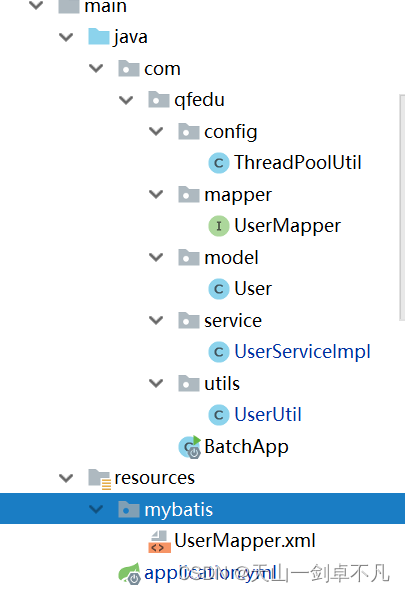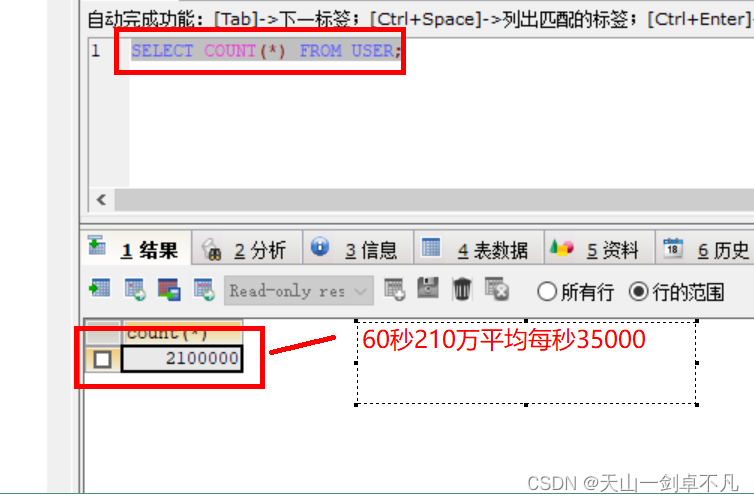如何用mybatis快速插入大量数据?
在公司业务开发过程中,经常会遇到需要往数据库表中插入大量数据的一个场景,如excel批量导入数据,如何快速的去插入数据呢,可以考虑使用批量插入(实测每秒能达到35000条,后附具体代码)
JDBC实现方式:
-
用一个 for 循环,把数据一条一条的插入。
-
生成一条插入 sql,类似这种
insert into user(name,pwd) values('aa','123'),('cc','123')...。
第一种方案,就是用 for 循环循环插入:
-
这种方案的优势在于,JDBC 中的 PreparedStatement 有预编译功能,预编译之后会缓存起来,后面的 SQL 执行会比较快并且 JDBC 可以开启批处理,这个批处理执行非常给力。
-
劣势在于,很多时候我们的 SQL 服务器和应用服务器可能并不是同一台,所以必须要考虑网络 IO,如果网络 IO 比较费时间的话,那么可能会拖慢 SQL 执行的速度。
第二种方案,就是生成一条 SQL 插入:
-
这种方案的优势在于只有一次网络 IO,即使分片处理也只是数次网络 IO,所以这种方案不会在网络 IO 上花费太多时间。
-
当然这种方案有好几个劣势,一是 SQL 太长了,甚至可能需要分片后批量处理;二是无法充分发挥 PreparedStatement 预编译的优势,SQL 要重新解析且无法复用;三是最终生成的 SQL 太长了,数据库管理器解析这么长的 SQL 也需要时间。
采用第二种方式进行改良
具体实现思路:
想要拉高插入效率,肯定不能够一条一条插了,必须得foreach批量插入。
采用多线程进行异步插入,提升性能
我们不可能单次提交多次insert,大量插入操作会很耗时,短时间内完不成,可以采用定时任务
直接上代码操作!!
创建maven工程
SpringBoot整合mybatis实现
创建表:
CREATE TABLE `user` ( `id` INT(11) NOT NULL AUTO_INCREMENT, `username` VARCHAR(30) DEFAULT NULL, `pwd` VARCHAR(20) DEFAULT NULL, `sex` INT(11) DEFAULT NULL, `birthday` DATETIME DEFAULT NULL, PRIMARY KEY (`id`)) ENGINE=MyISAM DEFAULT CHARSET=utf8注意:MyISAM效率会比INNODB快。
pom.xml
org.springframework.boot spring-boot-starter-parent 2.3.4.RELEASE org.mybatis.spring.boot mybatis-spring-boot-starter 2.1.0 mysql mysql-connector-java org.springframework.boot spring-boot-starter-web org.projectlombok lombok true org.springframework.boot spring-boot-starter-test test 启动类
@SpringBootApplication@EnableScheduling //开启定时任务public class BatchApplication { public static void main(String[] args) { SpringApplication.run(BatchApplication.class,args); }}application.yml
server: port: 9999spring: datasource: driver-class-name: com.mysql.cj.jdbc.Driver url: jdbc:mysql://localhost:3306/springboot?useUnicode=true&characterEncoding=utf-8&useSSL=false&serverTimezone=UTC username: root password: 123mybatis: mapper-locations: classpath:mybatis/*.xml type-aliases-package: com.qfedu.modelUser.java
@Datapublic class User { private int id; private String username; private String pwd; private int sex; private LocalDate birthday;}UserMapper.java
@Mapperpublic interface UserMapper { void insertBatch(@Param("userList") List userList);} UserMapper.xml
insert into user (username,pwd,sex,birthday) values (#{item.username}, #{item.pwd}, #{item.sex}, #{item.birthday}) 业务层采用定时任务
SpringBoot默认整合了scheduled,使用步骤:
-
在引导类加入@EnableScheduling注解,开启定时任务
-
在业务层方法上加入 @Scheduled注解,定义cron表达式周期执行
业务层方法中开启的线程可以根据当前机器的配置来修改,这里开了7个线程,每个线程去执行20次循环,一次添加5000条数据,注意mybatis批量插入的时候不建议超过10000条错误,容易产生,主要是数据量过大,栈内存溢出了。
@Componentpublic class UserServiceImpl { @Autowired private UserMapper userMapper; @Autowired //线程池 private ThreadPoolExecutor executor; @Scheduled(cron = "0/20 * * * * ?") //每隔20秒执行一次 public void addList(){ System.out.println("定时器被触发"); long start = System.currentTimeMillis(); for (int i = 0; i < 7; i++) { Thread thread = new Thread(() -> { try { for (int j = 0; j < 20; j++) { userMapper.addList(UserUtil.getUsers(5000)); } } catch (Exception e) { e.printStackTrace(); } }); try { executor.execute(thread); } catch (Exception e) { System.out.println(e.getMessage()); } } }}生成对象的util
public class UserUtil { private static Random random = new Random(); public static List getUsers(int num){ List users = new ArrayList<>(); for (int i = 0;i 线程池配置
线程池参数:
corePoolSize 核心线程数,在线程池中要保证的最小线程数
mainumPoolSize 最大线程数,线程池中能运行的最大线程数
keepAliveTime 保证存活时间,当线程空闲时间,多久会回收线程。
unit 和keepAliveTime配合使用,时间单位
workQueue 工作队列,用于存储任务在任务被执行之前
@Configurationpublic class ThreadPoolExecutorConfig { @Bean public ThreadPoolExecutor threadPoolExecutor() { //线程池中6个线程,最大8个线程,用于缓存任务的阻塞队列数5个 ThreadPoolExecutor executor = new ThreadPoolExecutor(6, 8, 5, TimeUnit.SECONDS, new ArrayBlockingQueue<>(100)); executor.allowCoreThreadTimeOut(true);//允许超时 return executor; }}完整项目结构

测试
启动引导类


来源地址:https://blog.csdn.net/dengfengan/article/details/127379772
免责声明:
① 本站未注明“稿件来源”的信息均来自网络整理。其文字、图片和音视频稿件的所属权归原作者所有。本站收集整理出于非商业性的教育和科研之目的,并不意味着本站赞同其观点或证实其内容的真实性。仅作为临时的测试数据,供内部测试之用。本站并未授权任何人以任何方式主动获取本站任何信息。
② 本站未注明“稿件来源”的临时测试数据将在测试完成后最终做删除处理。有问题或投稿请发送至: 邮箱/279061341@qq.com QQ/279061341







![[mysql]mysql8修改root密码](https://static.528045.com/imgs/7.jpg?imageMogr2/format/webp/blur/1x0/quality/35)









